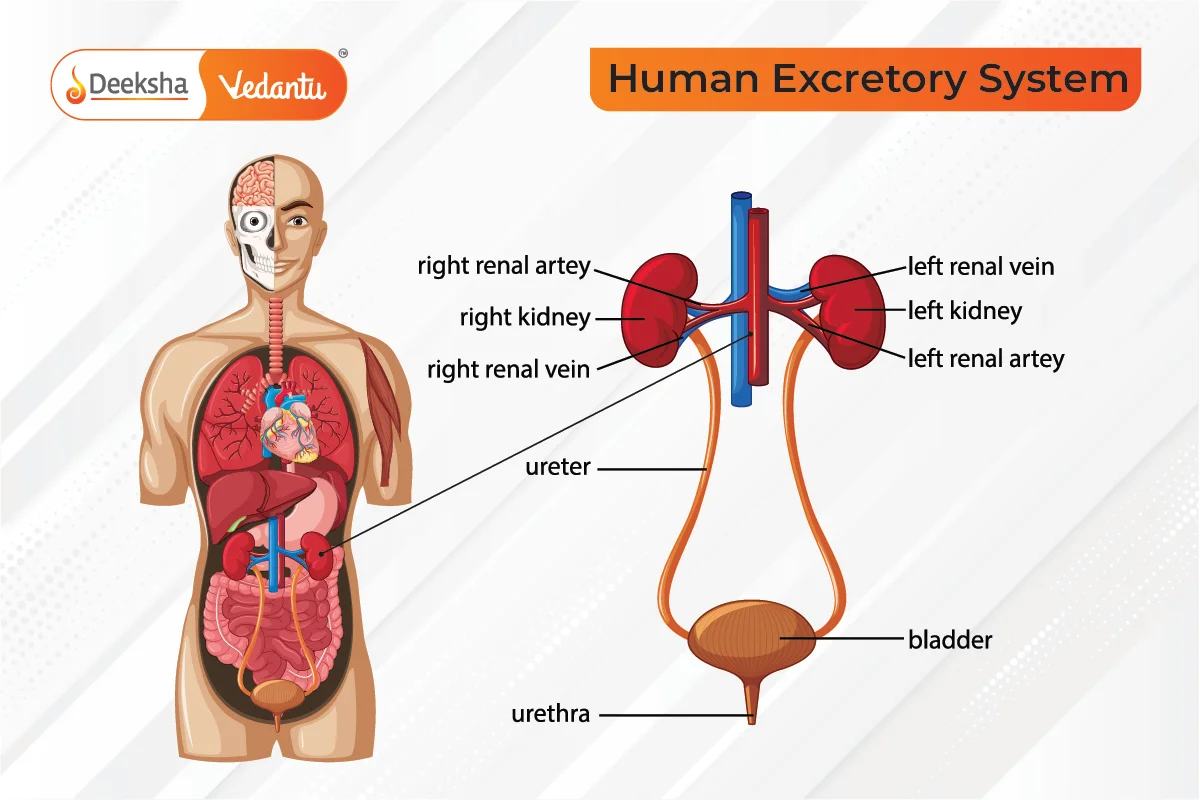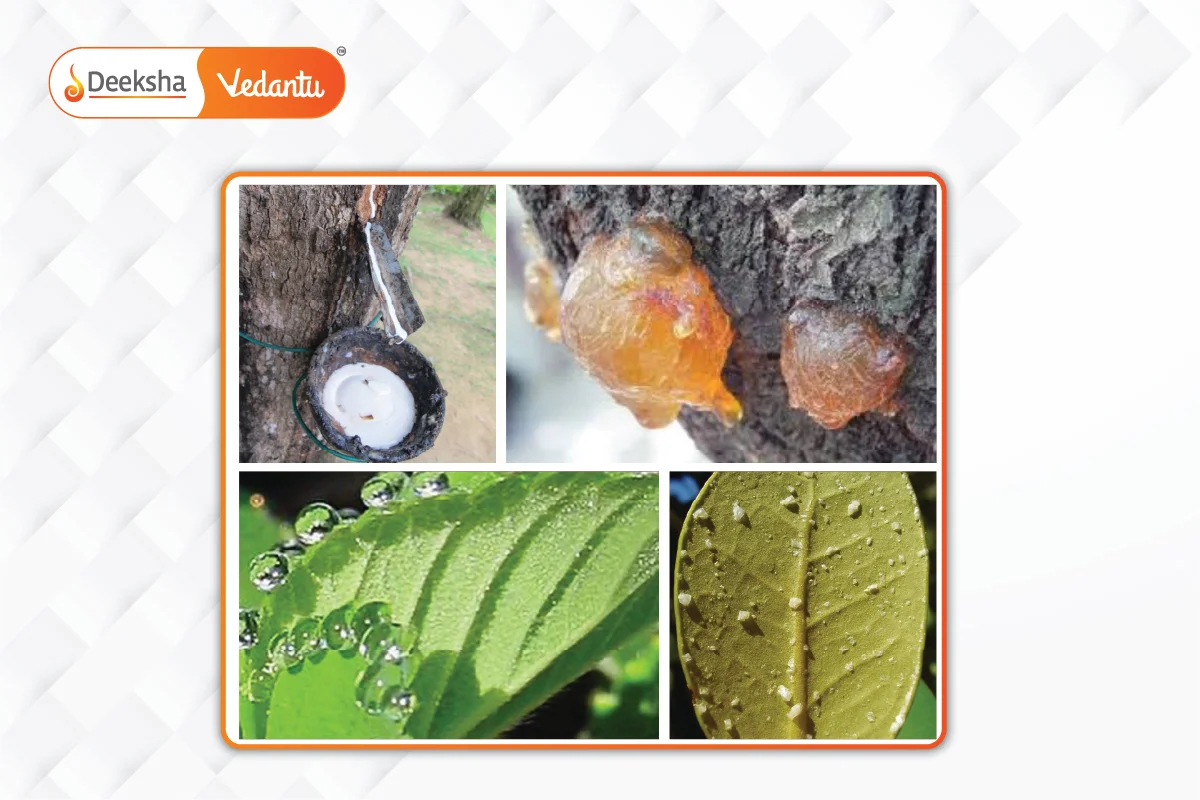Introduction
Excretion is a vital life process in living organisms that involves the removal of metabolic waste products. These waste products are generated during various chemical reactions in the body and, if not removed, can be toxic. The main excretory products in animals are nitrogenous wastes like urea, uric acid, and ammonia. The excretory system in humans is well developed, with the kidneys being the primary organs responsible for excretion.
In contrast, plants have a different mechanism of waste disposal since they do not produce nitrogenous wastes like animals. They rely on diffusion, transpiration, and storage mechanisms to get rid of excess or harmful substances.
Excretion in Human Beings
In humans, the excretory system ensures that metabolic waste, particularly nitrogenous waste from the breakdown of proteins and nucleic acids, is efficiently removed from the bloodstream and eliminated from the body.
Human Excretory System

The primary organs involved in human excretion are:
- Kidneys: The two kidneys are responsible for filtering the blood and removing urea, excess salts, and water to form urine.
- Ureters: These are tubes that carry urine from the kidneys to the urinary bladder.
- Urinary Bladder: A muscular sac that stores urine until it is excreted.
- Urethra: The tube through which urine is expelled from the body during urination.
Structure and Function of the Nephron
The nephron is the functional and structural unit of the kidney. Each kidney contains about a million nephrons, which filter the blood and produce urine. The main components of a nephron are:
- Glomerulus: A network of capillaries where blood is filtered. The glomerulus is located inside a structure called the Bowman’s capsule.
- Bowman’s Capsule: A cup-like structure that encases the glomerulus and collects the filtrate (filtered blood plasma) that contains water, urea, salts, and glucose.
- Proximal Convoluted Tubule: This portion reabsorbs nutrients like glucose, amino acids, and water back into the bloodstream.
- Loop of Henle: This part of the nephron extends into the medulla of the kidney and plays a crucial role in concentrating the urine by reabsorbing water and salts.
- Distal Convoluted Tubule: It fine-tunes the reabsorption of water and ions based on the body’s needs.
- Collecting Duct: The final part of the nephron, where the urine is concentrated further before being passed to the ureters.
Process of Urine Formation

Urine formation involves three main processes:
- Filtration: Blood entering the nephron through the glomerulus is filtered under pressure. All small molecules, such as water, urea, salts, glucose, and amino acids, pass into the Bowman’s capsule, while larger molecules like proteins and blood cells remain in the blood.
- Reabsorption: As the filtrate passes through the tubules of the nephron, essential substances like glucose, water, and ions are reabsorbed back into the blood. The amount of water reabsorbed is regulated based on the body’s hydration levels. The reabsorption process ensures that only waste materials and excess substances are excreted.
- Secretion: Additional wastes, like potassium and hydrogen ions, are secreted into the nephron to maintain the body’s pH balance.
- Concentration of Urine: The loop of Henle plays an essential role in concentrating urine by absorbing water and returning it to the bloodstream, thereby conserving water.
The final urine, composed of urea, water, salts, and other waste products, flows through the collecting ducts, enters the ureters, and is stored in the urinary bladder until excretion.
Regulation of Urine Volume and Concentration
- Antidiuretic Hormone (ADH): This hormone is secreted by the pituitary gland and regulates the amount of water reabsorbed in the nephron, particularly in the collecting ducts. When the body is dehydrated, ADH levels increase, leading to greater water reabsorption and concentrated urine. Conversely, when water levels in the body are high, ADH secretion decreases, resulting in diluted urine.
Excretion in Plants
Unlike animals, plants do not have specialized excretory organs. However, they still produce waste products that must be eliminated or managed. These waste products are generated during processes like photosynthesis and respiration.
Excretory Products in Plants
- Oxygen: During photosynthesis, plants produce oxygen as a by-product. This oxygen is released into the atmosphere through small pores in the leaves called stomata.
- Carbon Dioxide: During respiration, plants produce carbon dioxide as a waste product. This is also released through the stomata.
- Excess Water: Plants lose water through transpiration, which occurs mainly through the stomata of leaves. This process helps in cooling the plant and regulating the water balance.
- Other Waste Substances:
- Resins and Gums: Some plants produce and store waste materials like resins, gums, and latex. These substances accumulate in specific areas and may be excreted when the plant sheds its bark or branches.
- Tannins: Plants also store waste products in their tissues in the form of tannins, which can deter herbivores.

Mechanisms of Waste Removal in Plants
- Transpiration: Water vapor is lost from plant surfaces (mostly leaves) during transpiration, along with dissolved waste products.
- Leaf Fall: Some waste products are stored in leaves, and when the leaves are shed, the waste is removed along with them.
- Diffusion: Gaseous waste products like oxygen and carbon dioxide are excreted through diffusion. This is a passive process and occurs through the stomata or lenticels (small openings on the stems of woody plants).
- Excretion through Roots: Some plants excrete waste products into the soil through their roots.
Excretion in Other Organisms
Excretion in Amoeba
Amoeba, a unicellular organism, does not have specialized excretory organs. It uses the process of diffusion to get rid of waste products. Carbon dioxide and ammonia diffuse out of the cell directly into the surrounding water. Excess water is managed through a specialized structure called the contractile vacuole, which expels water from the cell to prevent bursting.
Excretion in Insects
Insects like grasshoppers have specialized excretory organs called Malpighian tubules. These tubules remove nitrogenous wastes, mainly uric acid, from the hemolymph (the insect equivalent of blood). The wastes are then excreted as a thick paste, helping insects conserve water, which is especially useful for those living in dry environments.
Excretion in Fish
Fish excrete nitrogenous wastes primarily in the form of ammonia, which is highly toxic but diffuses quickly into water. Fish expel ammonia through their gills, where it is diluted in the surrounding water. Freshwater fish must also constantly remove excess water, while marine fish conserve water due to the salty environment.
Practice Questions
Q1: Explain the role of the kidneys in excretion.
- Answer: The kidneys filter blood to remove waste products like urea, excess salts, and water. These wastes are combined to form urine, which is then expelled from the body. The kidneys also regulate the water balance and maintain the body’s pH levels.
Q2: What are nephrons, and how do they function in urine formation?
- Answer: Nephrons are the structural and functional units of the kidneys that filter the blood and produce urine. They carry out filtration, reabsorption, and secretion to form urine, which contains waste products like urea, excess salts, and water.
Q3: How do plants excrete waste products?
- Answer: Plants excrete oxygen and carbon dioxide through diffusion via stomata. They also lose excess water through transpiration. Some plants store waste products in leaves, bark, or roots, which are eventually shed.
Q4: Describe the process of excretion in an amoeba.
- Answer: In amoeba, excretion occurs through diffusion. Waste products like carbon dioxide and ammonia diffuse out of the cell into the surrounding water. Excess water is expelled through a contractile vacuole.
FAQs
Insects excrete uric acid because it is less toxic and conserves water. This is particularly beneficial for insects living in dry environments, as they need to minimize water loss.
Oxygen produced during photosynthesis is released into the atmosphere through tiny pores called stomata, located on the surface of leaves.
Nephrons filter blood through the glomerulus, where small molecules like water, salts, urea, and glucose pass into the Bowman’s capsule. This filtrate is then processed in the tubules, where essential substances are reabsorbed, and waste products are concentrated into urine.
Urea is formed in the liver through the urea cycle when excess amino acids are broken down. The nitrogen from amino acids is converted into ammonia, which is toxic. The liver converts ammonia into urea, which is less toxic and can be safely excreted by the kidneys.
The main excretory products in humans are urea, excess salts, water, and nitrogenous waste. Urea is produced by the liver during the breakdown of proteins and is excreted in urine.












Get Social